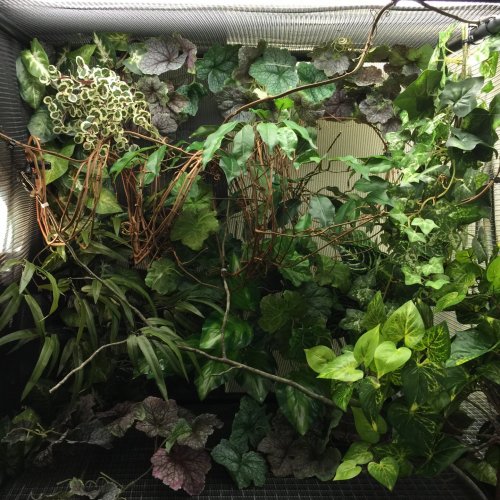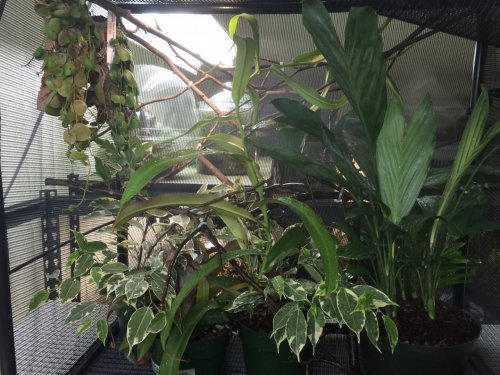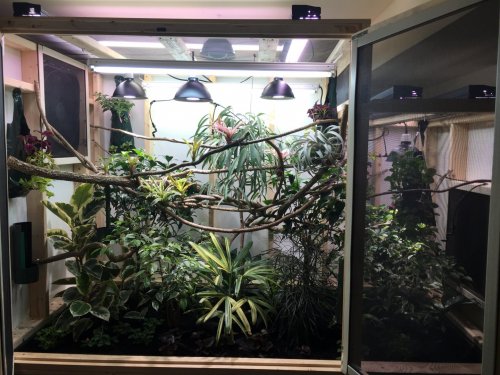Extensionofgreen
Chameleon Enthusiast
Correct me if I am wrong, but I believe you had the two in one enclosure and they weren't eating and continued to not eat when you separated them. Now she has some sort of infection that requires injectable antibiotics.
Add up the stress and stress is cumulative:
Stress of import;
Stress of new home and housed with male;
Stress of not eating;
Stress of another new cage;
Stress of being housed with a male;
Stress of being in a cage that is barely adequate for one parsonii let alone a male and a female;
Stress of going to vet;
Stress of injections/handling;
Stress to her digestive tract from the antibiotics:
Stress of force feeding when giving injections.
Just add it all up. Those are only the stresses that I remember off the top of my head. I don't think you understand how stressful their housing is. And I generally have not found vets, even experienced vets, up on husbandry of chameleons. They might be good medical practitioners but in general they are not great with the fine points of husbandry.
Stress suppresses the immune system. It is never a surprise to me that chameleons under a lot of stress have minor problem after minor problem and often don't live long. Just my two cents.
I agree that being imported, shipped to me, and having their enclosures changed was cumulative stress.
Where things go off in another direction is where you state they weren't eating, housed together, then continued to not eat, once separated, and that their caging was at any time inadequate.
The pair was supposedly housed together and hand feeding, according to the seller, so I initially attempted to house them together in a DENSLEY decked out enclosure. Both chameleons DID eat, initially, out of the box, in fact.
They both waxed and waned in their appetite and were separated on the supposition that they may not like being housed together, after a change from indoor caging, after being housed outdoors before, and with the set-up having a more confining feel, than the less opaque walls of the bird cage they were housed in, with the seller. Their in initial enclosures can be seen below, followed by the enclosure they live in now.
After separating them, their appetite continued to be inconsistent. It was most likely the feeling of confinement, presented by indoor screen caging, versus the outdoor bird cage they were in before they got to me, because nothing improved until they were settled, about 3 weeks after being separated. Things improved, but they still are less frequently than I'd have liked. Both animals gained 20 grams, within their first month, inspite of them not eating with enthusiasm.
I moved them into the large enclosure they are in now, once it was completed. That was in the last few days of May.
They both became much more active and began eating regularly. The new enclosure, with a more open feel and lots of light, vegetation, and visual barriers, seemed to have an immediate impact. Both animals improved, until I noticed the female not eating. The male continued to eat, and still does, daily, in fact.
The female could have developed stomatitis from stress from any number of factors. Being an import, being shipped, being moved from different enclosures, and yes, I've considered cohabitation. Because I so strongly want them to do well and provide them an ideal life, I am constantly observing and monitoring, in case separation is needed. It is presumptive and would cause MORE STRESS to yank her out of the spacious enclosure and return her to her old enclosure. I get that many people don't frequently house chameleons together and why that is. People also don't often offer the size enclosure, diet, and level of experience I do.
Their enclosure is 8' Left to Right, 6' 10" high in the tallest 2/3 and 6' at the shortest 1/3, and 4' front to back. The enclosure is planted with live plants, and is much brighter than the enclosures, before.
The female is already eating, after her second dose of Fortaz. I time her injections to conincide with the mistings, so she calms down, quickly. If she didn't do so well at staying in out of reach areas, I'd prefer giving the shot at night, so she doesn't see me and she goes right back to sleep, but handling her for the injections is an oppertunity to inspect the mouth, take weights, and offer her food.
I respect your opinion and your work with your chameleons, truly and authentically, but I also challenge you have faith that I am doing more than most to give these animals a great, not just adequate life and that I am very, very aware of what causes them stress and what that looks like.
The pictures below show first, what was their first enclosure, quickly to become the female's enclosure, followed by the male's, and finally the newest and larger enclosure.
The large enclosure may look sparse, but looking in from the side, there are walls of foliage, to where the pair can not see each other, if they choose, from several points, within the enclosure.
Dr.Stahl has also kept chameleons, including melleri and is the exception, as far as vets being good practitioners, but not fully aware of the husbandry needs of chameleons. He has also successfully performed surgery on parsonii and many, many chameleons.
Attachments
Last edited:



